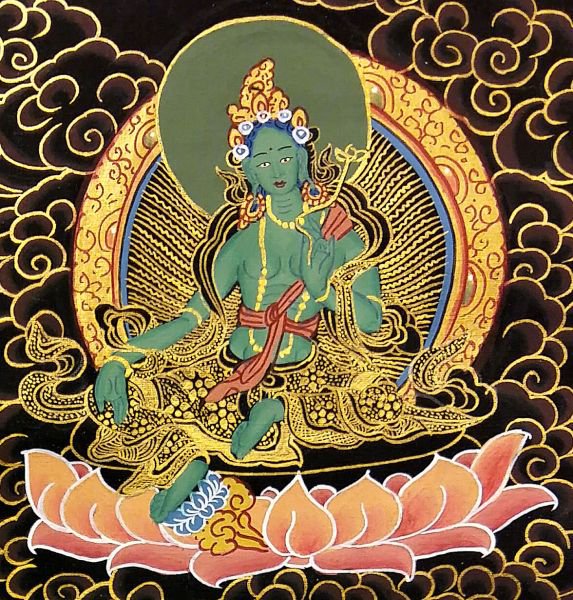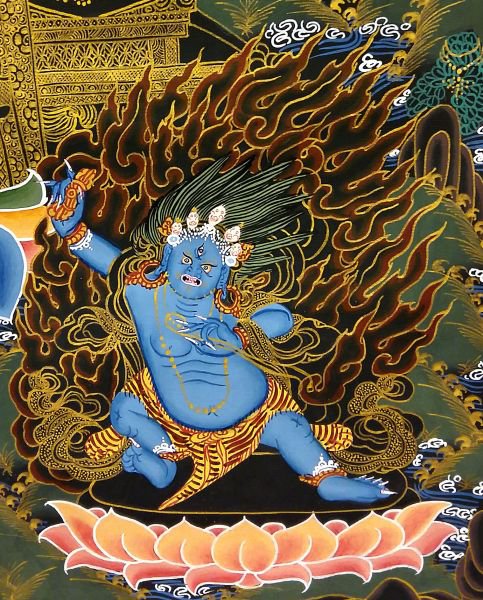Description
Maitreya Buddha with Green Tara is hand-painted on Cotton Canvas in Kathmandu, Nepal. Maitreya represents the future state of love emanating. This is embodied by the Adi Buddha Samantabhadra & gained by using the tools of Vajrayana ‘magical’ Buddhism & can be realized from the adamantine truth of emptiness embodied by Adi Buddha Vajradhara.
Maitreya Buddha is presented at the center of the thangka. Amitabha Buddha is presented at the top of the Maitreya Buddha in the thangka. Vajrapani is presented at the bottom right corner of the Maitreya Buddha in the painting. Manjushree is presented at the bottom left corner of the Maitreya Buddha in the painting.
Gren Tara is presented at the top right corner of the Maitreya Buddha in the painting. White Tara is presented at the top left corner of the Maitreya Buddha in the painting.
Iconography of Maitreya Buddha
He holds both hands in front of his heart in a hand position signifying the turning of the wheel of Buddhist teachings. The left hand holds the stem of a blue lotus or ‘night lotus’. The word Utpala means to ‘burst open’.
This supports an auspicious golden wheel that represents change, universal cycles of existence such as the changing of the hands of a watch, the seasons of the year, the earth & moon revolving around the sun, and these three, in turn, revolving with other planets. The right hand holds another lotus stem supporting a water pot which traditionally contains the primeval water carried by the creator Brahma.
This water of creation or water of life don’t confuse with the blue nectar of immortality]represents the pure conscious mind and its ability to regenerate and purify the conscious mind. The water pot is one of the eight auspicious symbols where the word Asta means eight. The green nimbus around his head represents his cosmic nature.
He is surrounded by a blooming ‘pink lotus’ and an unopened bud on her left hand. The Pink lotus blossoms represent the present love and the red unopened bud future love & yet be born Buddhas. The future here also refers to beneficial changes circumstances that will help bring them about.
Maitreya’s elongated earlobes represent patience; his topknot his abandonment of worldly possessions, the dot on his brow on the command chakra represents his transcendent wisdom. The thin blue aureole around his body signifies the highest level of understanding.
Chenrezig is presented at the center of the thangka. Amitabha Buddha is presented at the top of the Chenrezig in the thangka. Vajrapani is presented at the bottom right corner of the Chenrezig in the painting. Manjushree is presented at the bottom left corner of the Chenrezig in the painting.
Gren Tara is presented at the top right corner of the Chenrezig in the painting. White Tara is presented at the top left corner of the Chenrezig in the painting.
Iconography of Amitabha buddha
Amitabha Buddha is presented at the top of the Maitreya Buddha in the Painting. Amitabha is head of the Lotus Family, one of the oldest & significant of the Five Buddha Families. This family represents love, purity, compassion & peace. Amitabha Purelandis a place of infinite bliss & boundless light.
Amitabha Buddha is also one of the five Tathagatas representing the wisdoAmitabha Buddha is also one of the five Tathagatas representing the wisdom of discriminating awareness. Amitabha Buddha is red in color. He is represented in the stupa facing to the west. He rides on a peacock symbolizing that he can take away the suffering of others just as the peacock eats poisonous plants and yet his tail shines forth.
Mantra of Amitabha Buddha
The mantra of Amitabha Buddha is Om ami dewa hr.
Iconography of Manjushree
Manjushree is presented at the left down of the Maitreya Buddha in the Painting. Manjushree is the Bodhisattva who holds the flaming sword of enlightenment, by his left hand in a warning hand gesture in the left hand representing his realization of wisdom to cut through ignorance & wrong view. His right hand depicted in teaching holds the stem of a Blue Lotus flower upon which rests the Book (Pustaka) of Perfection of Transcendental Wisdom.
Mantra of Manjushree
The mantra of Manjushree is Om A Ra Pa Ca Na Dhih.
Iconography of Vajrapani
Vajrapani is presented at the right down of the Maitreya Buddha in the Painting. Vajrapaṇi is one of the earliest bodhisattvas of Mahayana Buddhism. He is the protector and guide of the Buddha and rose to symbolize the Buddha’s power.
Vajrapani is pictured dancing wildly within a halo of flames which represents transformation. He holds a vajra (thunderbolt) in his right hand which emphasizes the power to cut through the darkness of delusion. Vajrapani looks wrathful, but as a representation of the enlightened mind. He is completely free from hatred.
Mantra of Vajrapani
The mantra of Vajrapani is om vajrapani hum phat.
Iconography of Green Tara
Gren Tara is presented at the top right corner of the Maitreya Buddha in the painting. She is shown with a benevolent countenance seated upon a white moon disk which is associated with special restorative nectar associated with the naval chakra center. In Buddhists, the moon symbolizes the wisdom aspect which when coupled with compassion leads to Sakyamuni Buddha’s enlightenment. Her right hand is gracefully lowered in Varada mudra, the boon-granting gesture.
Green Tara’s special lotus is the blue lotus or ‘night lotus’ which she bears in both hands. The word Utpala means to ‘burst open’. Her left hand holds a stem with an open blooming flower and an unopened bud. The bent lower part of the stem represents the root.
The open blossom represents the present and also the present Buddha; the bud represents the future and also Buddhas yet to be born. The future here also refers to a safe journey’s end and future well-being. Her right-hand wisdom hand is in the gesture of giving refuge.
The third finger touches the thumb to create a circle representing the union of wisdom and compassion, and the three extended fingers symbolize the Three Jewels of Buddhism a. The Buddha State b. The Body of teachings c.
The Principles of the Universe The same hand holds the stem of a blue lotus representing her willingness to assist. The closed blossom in her right hand represents the past and also the Buddhas of the past. Green Tara is shown in a place of paradise called Khadiravani where Tara dwells. Khadiravani is described as a great mountain kingdom with many trees, flowers, and animals rainbow tails emanating from her outer aureole. The crescent moon and sun symbolize the union of males and females ubiquitous in Tantric art.
Mantra of Green Tara
The mantra of Green Tara is om tare tuttare ture soha.
Iconography of White Tara
White Tara is presented at the top left corner of the Maitreya Buddha in the painting. White Tara’s embodiment of peace is directed through loving compassion. From her serenity, she lends grace and dignity to situations and encourages the good to arise in all circumstances and situations.
The extra eye on her forehead, on the palms of her hands & the soles of her feet, represent her ability to see and understand the sufferings of all beings & her omniscient compassion toward the suffering.
Mantra of White Tara
The mantra of White Tara is Om Tare Tuttare Ture Mama Ayur Pune Gyana Puntin Kuru Swoha.











































Reviews
There are no reviews yet.